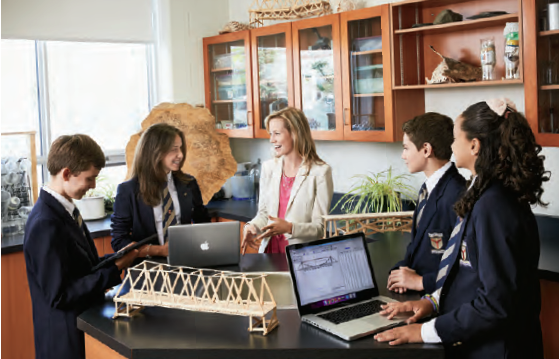Share this page
Grade 7 students at Holy Trinity School use bridge-building software to discover links between math, science and art.
By Stefan Dubowski
Photo: Matthew Liteplo

The Challenge: Help students understand interconnections between different disciplines.
The Solution: Create an assignment in which students research bridge failures and potential solutions, and have them present their work to the class.
Lessons Learned: Teachers assign students to build popsicle-stick bridges so they learn the links between geometry, physics and structural integrity. But Shantel Popp, OCT, a science teacher at Holy Trinity School, an independent school in Richmond Hill, wanted her young bridge-builders to see connections between engineering, math and art as well.
To that end, Popp devised a lesson in which students use bridge-building software to explore structural designs. They also have to consider real-world parameters such as construction budgets and aesthetics to meet the lesson’s criteria.
First, students in groups of two or three choose from a Popp-approved list of failed bridges to consider, such as Tacoma Narrows in Washington, which wind twisted apart in 1940, or the Dee Bridge in England, which flexed to the breaking point in 1847. Students uncover the details of the disaster, learning why the structure failed.
Next, using their school-provided MacBook computers and Bridge Designer (available at bridgecontest.org), a free software program, the groups redesign their selected spans. The program provides instant feedback on tension, compression and other engineering principles, and it also calculates costs.
Students also have to name their group, and create a team logo and slogan to use when they present their bridge fix to the class. Popp recommends using Canva, a free graphic-design app (canva.com). This aspect of the assignment “draws in the whole class, because you’re engaging those students who have creative, artistic sides and want to show the class what they can do,” Popp says.
Observations: The students take to the assignment, using curiosity to drive creativity. “The final products show a dedication to learning and, using the method of inquiring and testing, design solutions in real time,” Popp says.
The assignment also helps students see subjects like math, physics and art as interdisciplinary, adding a new element to traditional STEM curricula. “It really became a STEAM project — science, technology, engineering, art and math.”
But developing the lesson wasn’t straightforward. For instance, Popp had to adjust the budget following student feedback. In the past, they told her the budget was too high, so they didn’t have to work especially hard to develop solutions. “I’ve settled on $300,000,” she says. At that, students “have to work. It’s about meeting all the markers: aesthetically pleasing, structurally sound and cost-effective.”
Popp still teaches students how to build popsicle-stick bridges. “Using hands-on materials in science is so important,” she says, “Incorporating technology in a way that enhances learning can be incredibly o beneficial for student success.”
The College’s professional advisory Use of Electronic Communication and Social Media (oct-oeeo.ca/1iqmDeO) guides members’ professional judgment in the use of technology.
Helpful Hint: Shantel Popp. OCT, worked with a librarian to scour databases such as AccessScience (accessscience.com) and The Canadian Encyclopedia (thecanadianencyclopedia.com) to find background material for Popp's bridge-redesign assignment.
What You’ll Need:
Steps to Take: